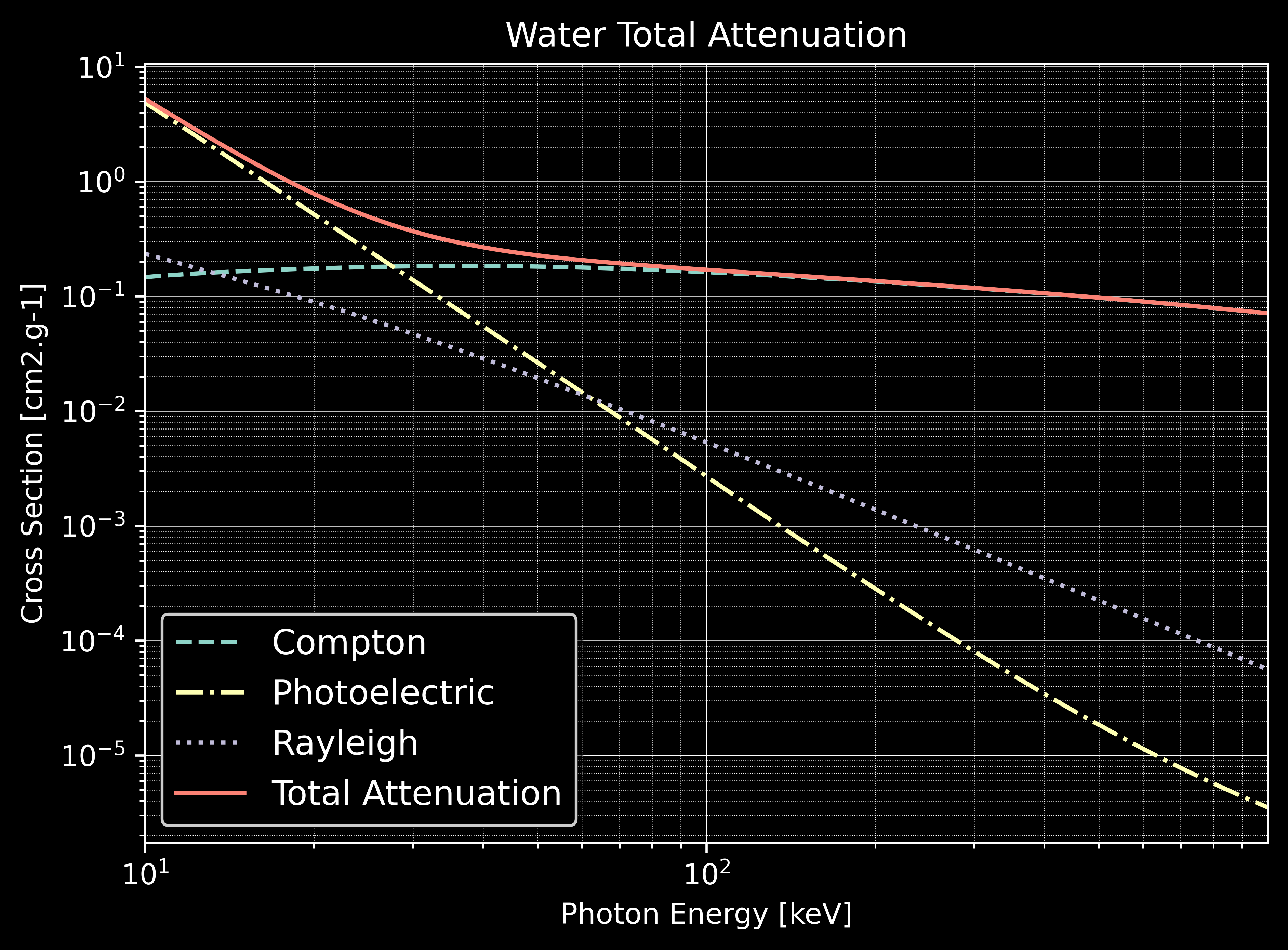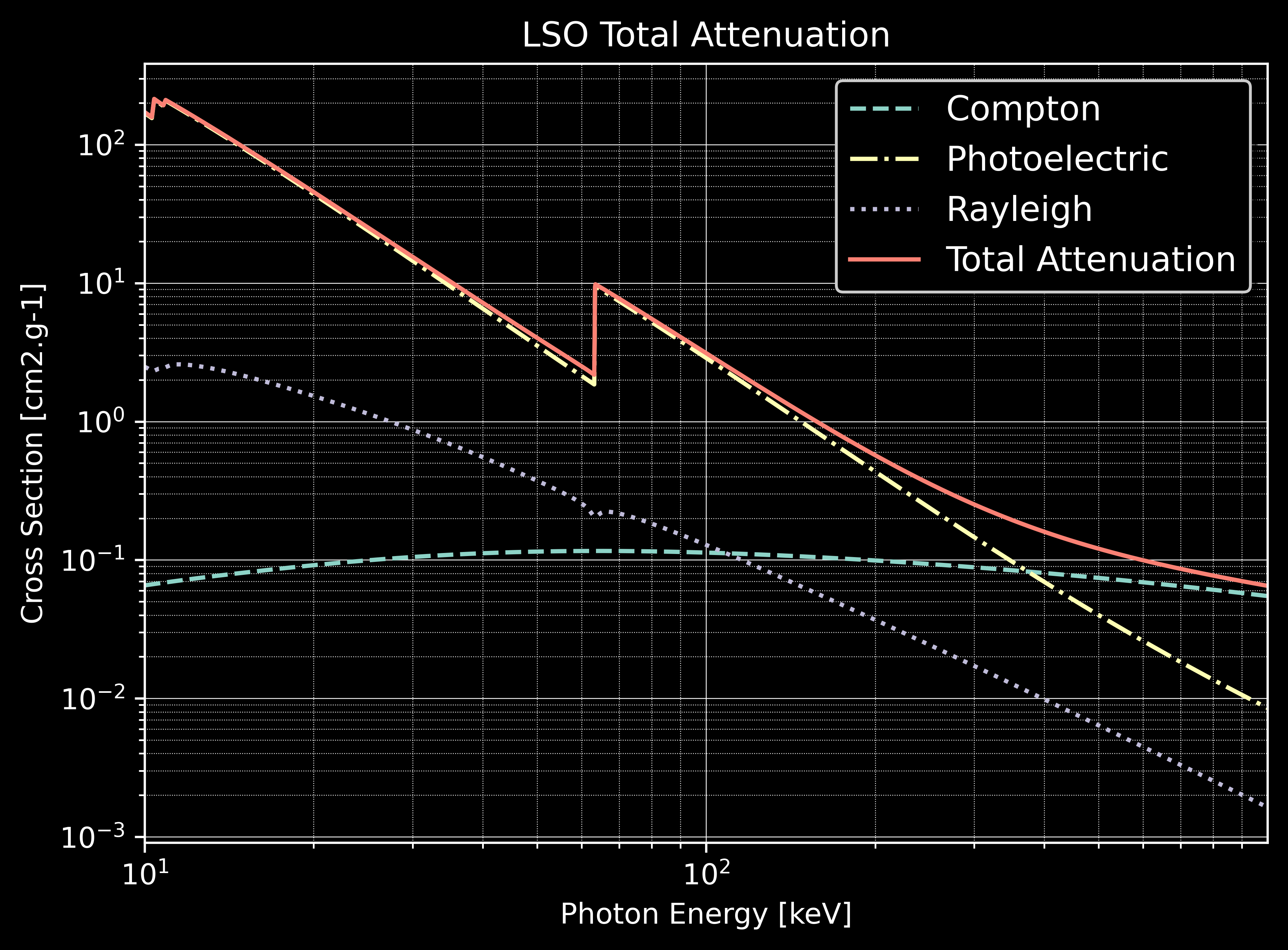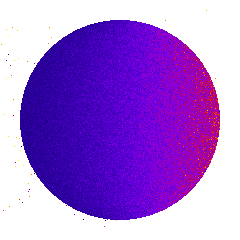Examples & Tools¶
A list of examples and tools are provided for GGEMS users. C++ and python instructions are given. For C++, a CMakeLists.txt file is mandatory for compilation.
Note
Examples are compiled and installed when the compilation option ‘BUILD_EXAMPLES’ is set to ON. C++ executables are installed in example folders.
Example 0: Cross-Section Computation¶
The purpose of this example is to provide a tool computing cross-section for a specific material and a specific photon physical process. The energy (in MeV) and the OpenCL device are set by the user.
$ python cross_sections.py [-h] [-d DEVICE] [-m MATERIAL] -p [PROCESS]-e [ENERGY]
-h/--help Printing help into the screen
-d/--device Setting OpenCL id
-m/--material Setting one of material defined in GGEMS (Water, Air, ...)
-p/--process Setting photon physical process (Compton, Rayleigh, Photoelectric)
-e/--energy Setting photon energy in MeV
The macro is in the file ‘cross_section.py’.
Verbosity level is defined in the range [0;3]. For a silent GGEMS execution, the level is set to 0, otherwise 3 for lot of informations.
GGEMSVerbosity(0)
opencl_manager.set_device_index(device_id)
GGEMSMaterial object is created, and each new material can be added. The initialization step is mandatory and compute all physical tables, and store them on an OpenCL device.
materials = GGEMSMaterials()
materials.add_material(material_name)
materials.initialize()
Before using a physical process, GGEMSCrossSection object is created. Then each process can be added individually. And finally cross sections are computing by giving the list of materials.
cross_sections = GGEMSCrossSections()
cross_sections.add_process(process_name, 'gamma')
cross_sections.initialize(materials)
Getting the cross section value (in cm2.g-1) for a specific energy (in MeV) is done by the following command:
cross_sections.get_cs(process_name, material_name, energy_MeV, 'MeV')
Example 1: Total Attenuation¶
Warning
This example is only available using python and the matplotlib library is mandatory.
This example is a tool for plotting the total attenuation of a material for energy between 0.01 MeV and 1 MeV. The commands are similar to example 0, and all physical processes are activated.
$ python total_attenuation.py [-h] [-d DEVICE] [-m MATERIAL]
-h/--help Printing help into the screen
-d/--device Setting OpenCL id
-m/--material Setting one of material defined in GGEMS (Water, Air, ...)
Total attenuations for Water and LSO are shown below:


Example 2: CT Scanner¶
In this CT scanner example, a water box is simulated associated to a CT curved detector. Only one projection is computed simulating 1e9 particles.
$ python ct_scanner.py [-h] [-d DEVICE]
-h/--help Printing help into the screen
-d/--device Setting OpenCL id
The water box phantom is loaded:
phantom = GGEMSVoxelizedPhantom('phantom')
phantom.set_phantom('data/phantom.mhd', 'data/range_phantom.txt')
phantom.set_rotation(0.0, 0.0, 0.0, 'deg')
phantom.set_position(0.0, 0.0, 0.0, 'mm')
Then CT curved detector is built:
ct_detector = GGEMSCTSystem('Stellar')
ct_detector.set_ct_type('curved')
ct_detector.set_number_of_modules(1, 46)
ct_detector.set_number_of_detection_elements(64, 16, 1)
ct_detector.set_size_of_detection_elements(0.6, 0.6, 0.6, 'mm')
ct_detector.set_material('GOS')
ct_detector.set_source_detector_distance(1085.6, 'mm')
ct_detector.set_source_isocenter_distance(595.0, 'mm')
ct_detector.set_rotation(0.0, 0.0, 0.0, 'deg')
ct_detector.set_threshold(10.0, 'keV')
ct_detector.save('data/projection')
Initialization of cone-beam X-ray source:
point_source = GGEMSXRaySource('point_source')
point_source.set_source_particle_type('gamma')
point_source.set_number_of_particles(1000000000)
point_source.set_position(-595.0, 0.0, 0.0, 'mm')
point_source.set_rotation(0.0, 0.0, 0.0, 'deg')
point_source.set_beam_aperture(12.5, 'deg')
point_source.set_focal_spot_size(0.0, 0.0, 0.0, 'mm')
point_source.set_polyenergy('data/spectrum_120kVp_2mmAl.dat')

Performance:
Device |
Computation Time [s] |
|---|---|
GeForce GTX 1050 Ti |
128 |
Quadro P400 |
404 |
Xeon X-2245 8 cores / 16 threads |
132 |
Example 3: Voxelized Phantom Generator¶
A tool creating voxelized phantom is provided by GGEMS. Only basic shapes are available such as tube, box and sphere. The output format is MHD, and the range material data file is created in same time than the voxelized volume.
$ python generate_volume.py [-h] [-d DEVICE]
-h/--help Printing help into the screen
-d/--device Setting OpenCL id
First step is to create global volume storing all other voxelized objets. Dimension, voxel size, name of output volume, format data type and material are defined.
volume_creator_manager.set_dimensions(450, 450, 450)
volume_creator_manager.set_element_sizes(0.5, 0.5, 0.5, "mm")
volume_creator_manager.set_output('data/volume')
volume_creator_manager.set_range_output('data/range_volume')
volume_creator_manager.set_material('Air')
volume_creator_manager.set_data_type('MET_INT')
volume_creator_manager.initialize()
Then a voxelized volume can be drawn in the global volume. A box object is built with the command lines below:
box = GGEMSBox(24.0, 36.0, 56.0, 'mm')
box.set_position(-70.0, -30.0, 10.0, 'mm')
box.set_label_value(1)
box.set_material('Water')
box.initialize()
box.draw()
box.delete()
Example 4: Dosimetry¶
In dosimetry example, a cylinder is simulated computing absorbed dose inside it. Different results such as dose, energy deposited… can be plotted. An external source, using GGEMS X-ray source is simulated generating 2e8 particles.
First, the cylinder phantom is loaded:
phantom = GGEMSVoxelizedPhantom('phantom')
phantom.set_phantom('data/phantom.mhd', 'data/range_phantom.txt')
phantom.set_rotation(0.0, 0.0, 0.0, 'deg')
phantom.set_position(0.0, 0.0, 0.0, 'mm')
Then dosimetry object is associated to the previous phantom, storing all data during particle tracking:
dosimetry = GGEMSDosimetryCalculator('phantom')
dosimetry.set_output('data/dosimetry')
dosimetry.set_dosel_size(0.5, 0.5, 0.5, 'mm')
dosimetry.water_reference(False)
dosimetry.minimum_density(0.1, 'g/cm3')
dosimetry.uncertainty(True)
dosimetry.photon_tracking(True)
dosimetry.edep(True)
dosimetry.hit(True)
dosimetry.edep_squared(True)
And finally an external source using GGEMSXRaySource is created:
point_source = GGEMSXRaySource('point_source')
point_source.set_source_particle_type('gamma')
point_source.set_number_of_particles(200000000)
point_source.set_position(-595.0, 0.0, 0.0, 'mm')
point_source.set_rotation(0.0, 0.0, 0.0, 'deg')
point_source.set_beam_aperture(5.0, 'deg')
point_source.set_focal_spot_size(0.0, 0.0, 0.0, 'mm')
point_source.set_polyenergy('data/spectrum_120kVp_2mmAl.dat')

Dose absorbed by cylinder phantom¶

Uncertainty dose computation¶
Photon tracking in phantom¶
Performance:
Device |
Computation Time [s] |
|---|---|
GeForce GTX 1050 Ti |
253 |
Quadro P400 |
1228 |
Xeon X-2245 8 cores / 16 threads |
570 |